|
Versteigerungen
und Auktionen
Österreich Portal Seiten
AMD Infos, Treiber und News
meine sonstigen Seiten:
willkommen im albernet
Tipps und Empfehlungen
|
AMD Athlon Sockel A Prozessoren - Alber Homepage
AMD Prozessoren für Sockel-A - der AMD Athlon XP mit allen Modellen, Barton, Thunderbird Thoroughbred Palomino Morgan Spitfire Duron - Core Bezeichnungen, Herstellungsprozess und Technologie, Taktfrequenzen, Die Size, CPU Sockel, Bustakt, L1 + L2 Cache, Befehlssätze, Transistoren und Kernspannung - Übersicht, Informationen und Technische Daten für AMD Slot-A und Socket 462 Info
AMD Athlon XP Prozessor
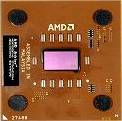
Die Angaben für die Temperatur, Spannung, Stromstärke
und Verlustleistung beziehen sich auf die maximal zulässigen Werte
-
Es wurden die internen Codebezeichnungen angegeben
- AMD Thunderbird bzw. AMD Spitfire steht für die ersten AMD Athlon und AMD Duron
Prozessoren für den Sockel A
-
AMD Palomino steht für die AMD Athlon XP und AMD Athlon MP
-
AMD Morgan für die neuen AMD Duron Prozessoren
AMD Athlon XP und MP4 haben zusätzliche Prozessor Features
-
SSE Befehlssatzerweiterung
-
Größerer TLB (Translation Lookaside Buffer)
-
Spekulatives Data Prefetch in Hardware (hardwareseitige Vorab Datenzugriff -
verbessere Sprungvorhersage)
Dabei werden Daten bereits vorab in den Cache der CPU geladen (die der
Prozessor basierend auf dem ausgeführten Befehlsablauf brauchen wird)
-
Dort kann auf sie schneller zugegriffen werden, was wiederum die
Anwendungsleistung steigert
AMD Barton - AMD Thoroughbred (2 Modelle)
| Prozessor |
Thoroughbred A-Core |
Thoroughbred B-Core |
Barton |
Herstellungs-
technologie |
0,13 Micron,
6 Lagen Metall |
0,13 Micron,
6 Lagen Metall |
0,13 Micron,
6 Lagen Metall |
| Die-Size |
80 mm² |
80 mm² |
101 mm² |
Taktfrequenz
in MHz |
1466 - 1800 |
1466 - 2250 |
1833 - 2200 |
| CPU-Sockel |
Sockel A |
Sockel A |
Sockel A |
Cpu-Bustakt
in MHz |
133 DDR |
133 DDR
166 DDR |
166 DDR
200 DDR
|
L1 Cache
in Kbyte |
64 + 64 |
64 + 64 |
64 + 64 |
L2 Cache in Kbyte
und Cache Interface |
256 "on DIE" und 64 Bit |
256 "on DIE" und 64 Bit |
512 "on DIE" und 64 Bit |
| L2 Cache-Takt |
Prozessortakt |
Prozessortakt |
Prozessortakt |
MMX-Befehlssatz
3DNow(+) |
ja (3DNow Professional) |
ja (3DNow Professional) |
ja (3DNow Professional) |
| Transistoren |
37,2 Millionen |
37,2 Millionen |
54,3 Millionen |
Anzahl der Befehle
SIMD FPU
MMX Streaming
DSP-Funktionen
SSE-Befehle |
21
19
5
51 |
21
19
5
51 |
21
19
5
51 |
| Multiprozessorfähig |
offiziell Athlon MP
(inoffiziell Athlon XP auch) |
offiziell Athlon MP
(inoffiziell Athlon XP auch) |
offiziell Athlon MP
(inoffiziell Athlon XP auch) |
| Kernspannung |
1,5 - 1,65 Volt |
1,5 - 1,6 Volt |
1,65 Volt |
| Verlustleistung |
49,4 - 67,9 Watt |
68,3 Watt |
68,3 - 74,3 Watt |
Stromstärke und
max. Temperatur
|
32,9 - 41,2 Ampere
90 C°
85 C° (2200+) |
- 41,4 Ampere
85 C° |
41,4 - 45 Ampere
85 C° |
Ratings und die Taktraten
von AMD Athlon XP Barton Core Prozessoren
AMD Athlon XP Prozessor - Modell 10 Barton

-
Athlon XP 2500+ - 1,833 GHz - 166 MHz FSB
-
Athlon XP 2800+ - 2,083 GHz - 166 MHz FSB
-
Athlon XP 3000+ - 2,167 GHz - 166 MHz FSB
-
Athlon XP 3000+ - ? - 200 MHz FSB
-
Athlon XP 3200+ - ? - 200 MHz FSB
CPU ID für Modell 10
Das Barton Core meldet sich mit der CPU ID 681
Ratings und die Taktraten von AMD Athlon XP
Thoroughbred A und B Core Prozessoren
AMD Athlon XP Prozessor - Modell 8 Thoroughbred B Core
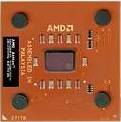
- Athlon XP 1700+ - 1,47 GHz
-
Athlon XP 1800+ - 1,53 GHz
-
Athlon XP 1900+ - 1,60 GHz
-
Athlon XP 2000+ - 1,67 GHz
-
Athlon XP 2100+ - 1,73 GHz
-
Athlon XP 2200+ - 1,80 GHz
-
Athlon XP 2400+ - 1,93 GHz
-
Athlon XP 2600+ - 2,133 GHz
-
Athlon XP 2600+ - 2,083 GHz - 166 MHz FSB
-
Athlon XP 2700+ - 2,167 GHz - 166 MHz FSB
-
Athlon XP 2800+ - 2,250 GHz - 166 MHz FSB (praktisch nicht verfügbar gewesen)
AMD Athlon XP Prozessor - Modell 8 Thoroughbred A Core
- Athlon XP 1700+ - 1,47 GHz
-
Athlon XP 1800+ - 1,53 GHz
-
Athlon XP 1900+ - 1,60 GHz
-
Athlon XP 2000+ - 1,67 GHz
-
Athlon XP 2100+ - 1,73 GHz
-
Athlon XP 2200+ - 1,80 GHz
CPU ID für Modell 8
Das Thoroughbred A Core hat die CPU ID 680 und das
Thoroughbred B Core die CPU ID 681
Ratings und die Taktraten
von Duron Morgan Applebred Prozessoren
AMD Duron Prozessor - Modell 7 Morgan Applebred
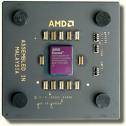
CPU ID für Modell 7
Ratings und die Taktraten
von Athlon XP Palomino Prozessoren
AMD Athlon XP Prozessor - Modell 6 Palomino
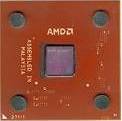
- Athlon XP 1500+ - 1,33 GHz
-
Athlon XP 1600+ - 1,40 GHz
-
Athlon XP 1700+ - 1,47 GHz
-
Athlon XP 1800+ - 1,53 GHz
-
Athlon XP 1900+ - 1,60 GHz
-
Athlon XP 2000+ - 1,67 GHz
-
Athlon XP 2100+ - 1,73 GHz
CPU ID für Modell 6
Liste AMD
Desktop Prozessoren SockelA Socket 462
Ratings und die Taktraten
von Duron Spitfire Prozessoren
AMD Duron Spitfire
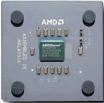
CPU ID für Modell 5
Der Prozessor mit dem "Spitfire-Core" benötigt eine Spannung von
1.4 Volt.
Den Energieverbrauch des 600-MHz-Chips beträgt rund 20 Watt. Der 700er soll
etwa 24 Watt verbrauchen. Zum Vergleich: Der AMD K6-2+ mit
PowerNow!-Technologie braucht mit 550 MHz nur rund 14 Watt. Im
Bereitschafts-Modus soll die Leistungsaufnahme des Mobile Duron unter 5 Watt
liegen. Der "Spitfire-Kern" oder Core wurde ohne
PowerNow!-Technologie designt, ist also nicht optimal für den Einsatz in
mobilen Rechnern geeignet
Ratings und die Taktraten
von Athlon Thunderbird 4 Prozessoren
AMD Athlon Prozessor - Modell 4 Thunderbird
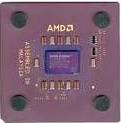
Anhand des Bildes, kann man die Spezifikation der CPU entziffern.
Zu beachten wäre die Bezeichnung für Prozessoren mit 100MHz FSB und 133MHz
FSB (Modell C)
CPU ID für Modell 4
Revision A4 A5 A6 A7 - CPU ID 642
Ratings und die Taktraten
von Athlon K7 Prozessoren
AMD Athlon Prozessor - Modell 2 - Slot A!

Anhand des Bildes kann man die Spezifikation des Athlon Modell 2 entziffern.
Beim Modell 2 handelt es sich um die verbesserte Version des Athlon (K75),
hergestellt im 0,18µm Prozess
CPU ID für Modell 2
- Revision A1 - CPU ID 621
-
Revision A2 - CPU ID 622
Ratings und die Taktraten
von Athlon K7 Prozessoren
AMD Athlon Prozessor - Modell 1
Anhand des Bildes, kann man die Spezifikation des Athlon Modell 1 entziffern.
Beim Modell 1 handelt es sich um den Ur Athlon hergestellt im 0,25µm Prozess

CPU ID für Modell 1
-
Revision C1 - CPU ID 611
-
Revision C2 - CPU ID 612
AMD PROZESSOR K6
- K6 2 - K6 - 3
AMD K6 3 450 MHZ Prozessor
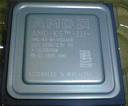
K6-2+/K6-III+: Multiplikator per Software verändern und optimieren
-
Für Besitzer von einem dieser Prozessoren habe ich eine gute Nachricht
-
Sie können selbst den Multiplikator ihrer CPU, im laufenden Betrieb, verändern
-
So könnt ihr bequem mal ausprobieren, ob die CPU einen höheren Takt verträgt
-
Das Programm k6clkwin ermöglicht das Verändern des Multiplikators
unter Windows
-
Alternativ kann man auch das Programm Central Tweak Unit verwenden, das
mehrere Tweaktools vereint
Für andere CPU´s (K6-2/K6-III) ist das Programm nicht geeignet
AMD K6 2 + 400 MHZ Prozessor
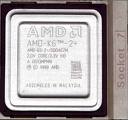
CXT-Core
-
Man erkennt das CXT-Core am Aufdruck beim Prozessor links unten
-
Das alte Core hatte dort die Zahl 26350 stehen
-
Beim CXT-Core steht dort 26351
-
Auch die CPUID-Kennung hat sich geändert
-
Das alte Model meldete - Fam. 5, Mod. 8, Step 0
-
Das CXT-Core meldet - Family 5, Model 8, Stepping 12
-
Der CPU-Multiplikator 2x wird als 6x interpretiert
-
Ein Beispiel dazu: Der Prozessor kann auf einem Mainboard mit max. FSB von
66MHz mit 400MHz (6x66) betrieben werden
-
Das Feature "Write Combining" kam hinzu
-
Das Feature "Write Allocation" wird anders initialisiert
-
Ein aktuelles Bios ist erforderlich
über AMD
Advanced Micro
Devices
|